Josh Holloway Battle Of The Year
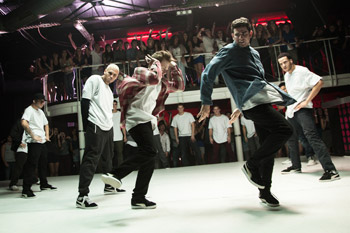
Battle Of The Year
Cast: Josh Holloway, Laz Alonso, Josh Peck, Caity Lotz, Chris Brown
Director: Benson Lee
Genre: Drama, Dance
Rated: PG
Running Time: 110 minutes
Synopsis: With compelling characters and vibrant dance sequences, Battle Of The Year is set in the international world of B-boying. Unforgettable images frame the intimate stories of an all-star American dance crew who, with the help of their tough coach (Josh Holloway), struggle to reach their dreams despite being misunderstood by society and even their own families. Their lives collide in France where their skills are put to the ultimate test: the 'Battle of the Year" finals, with crews from 18 nations vying for the title of World Champion.
Battle Of The Year
Release Date: December 12th, 2013
About The Production
B-boying is the innovative and athletic dance form that originated on the streets of New York City during the 1970s and became one of the four cornerstones of hip-hop culture, along with emceeing, graffiti and DJing. Dubbed 'break dancing" by the media, b-boying achieved overwhelming visibility in popular culture. Its luster eventually faded in the U.S., even as it continued to flourish around the world, as director Lee Benson discovered in his award-winning 2007 documentary, Planet B-Boy. Today, the basic moves first developed over 30 years ago have evolved into a highly sophisticated and acrobatic form of dance that can be legitimately compared to top-flight Olympic gymnastics.
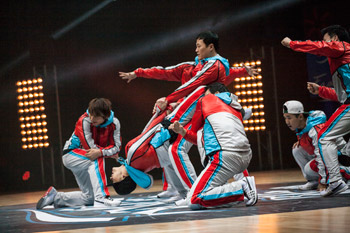 'The world of b-boying has become global," says Lee Benson. 'In Battle of the Year, which was inspired by my documentary, a coach is asked to put together a Dream team made up of the best b-boys in America with the sole mission of winning the Battle of the Year, which is like the World Cup of b-boying. More than 20 countries compete every year. The Dream team has a chance to bring the gold back home to America, where b-boying started, for the first time in 15 years."
'The world of b-boying has become global," says Lee Benson. 'In Battle of the Year, which was inspired by my documentary, a coach is asked to put together a Dream team made up of the best b-boys in America with the sole mission of winning the Battle of the Year, which is like the World Cup of b-boying. More than 20 countries compete every year. The Dream team has a chance to bring the gold back home to America, where b-boying started, for the first time in 15 years."
Battle of the Year (or BOTY) is a real life event that takes place each year in France, attracting crews from around the world. 'The competition has been going on for over 20 years," says producer Amy Lo, who also collaborated with Lee Benson on his documentary. 'It's a global event that attracts thousands of people. You can't imagine the energy."
According to Lee Benson, b-boying grew out of a need for young people in the Bronx to express themselves through dance. 'Wherever it goes, it represents the disenfranchised, so it makes sense that it was adopted by so many different cultures. It gives an option to kids who don't have the opportunity to go to traditional dance schools."
Even before Lee and Lo completed Planet B-Boy, they recognised the potential to create a feature film that would reintroduce the b-boy dance phenomenon to the country in which it began. Finding the right framework for their movie was their first challenge. Producer Tripp Vinson of Vinson Films helped the pair develop the property into a feature film.
Vinson says he was peripherally aware of b-boying from its '80s heyday. 'But Planet B-Boy was my real introduction to the culture. One of most compelling things about it is that the people and their stories engage the viewer at least as much as the dance. Their heart and warmth, as well as the struggles they go through to pursue their dream, sucked me in and I felt that it would make a great feature film."
Lee Benson's documentary is an in-depth, insider's look at the international b-boy scene that stretches from Japan, France, Germany and South Korea back to the United States. Using it as a jumping off point, the filmmakers looked for an approach to set their film apart from typical dance movies. 'Contemporary dance pictures tend to stick to a formula," says Lee Benson. 'Ballerina meets street dancer. He gives her flavor and she civilises him. That storyline has been beaten to a pulp, so it was the last thing we wanted to do. We came up with the idea of turning this into a sports film, which seemed like a natural fit. It's about competition and the dancers are physically on par with elite athletes."
Elements of teamwork and redemption are woven throughout the story, says Amy Lo. 'It is a very American story, with a very diverse group of people with big egos learning to put them aside to achieve a common goal."
Although the storyline is strictly fictional, it is deeply infused with the spirit of the documentary, using elements of different dancers' experiences to craft a classic story. 'A brilliant coach has fallen on hard times and a hip hop executive wants him to put together the best dance crew in the world," says Tripp Vinson. 'The world of b-boying tends to be about the individual and the coach teaches them to become a team so that they can compete in the Battle of the Year."
The discipline of b-boying has evolved tremendously since the early days of breaking, making it a study in individualism. 'The kids overseas have taken it and put their own stamps on it," Amy Lo continues. 'It feeds back into the U.S. on the Internet. All the b-boys study videos from events across the world and eventually that informs their own style. The cross-pollination is really fascinating."
Lee Benson says that while his interest in b-boying is deep and passionate, he was never a real b-boy himself. 'I have always been a huge fan. I was first exposed to b-boying when I saw Flashdance. Jennifer Biels is walking down the street and she runs into a group of b-boys. I'd never seen people dance like that before. There was a host of other movies that came out afterwards, like Beat Street and Breaking. I watched those as well and I was completely sucked in."
A decade later, Lee Benson had finished his first film and was wondering what to do next. 'I happened to see Flashdance on television. When I saw that scene, I started to wonder what happened to the b-boys. Through the Internet, I discovered this event called Battle of the Year and I became obsessed with it."
He learned that not only were the b-boys still around, they had gone international. 'And they had evolved into these really powerful athletes, but no one seemed to know about it. Wherever in the world it has gone, b-boying has come to represent the disenfranchised or ignored, the people without resources or advantages."
He equates the art form with 1950s-era rock and roll. 'It is was a purely American thing that came out of blues and shocked the world. Then it went around the globe and was reinterpreted by other cultures before coming back here. Hip hop has the power of rock. It represents youth. That's why it has proliferated worldwide."
And like rock and roll, you either have it or you don't, he believes. 'The best b-boys are the ones who've dedicated their lives to it. They draw on their personal experiences for inspiration and ideas. One thing I find that the best have in common is that they don't feel they chose b-boying. They believe b-boying chose them."
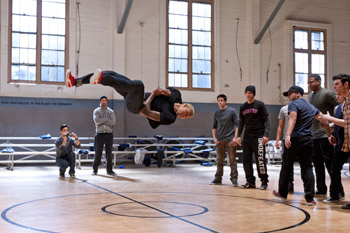 Finding The Dream Team
Finding The Dream TeamThe cast of Battle of the Year combines experienced actors with top street dancers to create a visceral and authentic picture of the reality of life as a b-boy. 'It's a really good mix," says Amy Lo. 'The actors were really respectful of the dancers, who are most often the unsung heroes in a situation like this, but we give them all their moment at center stage."
Josh Holloway plays Jason Blake, the down-and-out coach who redeems himself as he teaches the boys to trust him and each other enough to become a real team. 'I wasn't familiar with Josh from his role on -Lost,' but from the moment I met him, I just liked him," says Lee Benson. 'He's a really genuine person and very professional in his approach to the work. During rehearsals, I was blown away by the way he redefined the coach. He really dug deep into this character and brought such depth and humanity to it. A really good coach is a mentor and Josh Holloway achieved that with a lot of the guys on screen, as well as off camera."
Josh Holloway admits to being a closet b-boy enthusiast since his days as a high-school basketball player. 'I've been into dancing my whole life, but I never threw it out there in public," he says. 'My basketball team had some really good b-boys on it and we even integrated moves into our warm-ups. When I saw the documentary, I was astonished by the athleticism and the evolution of b-boying."
But even more than the dancing, he was drawn to the coach's story. 'It grabbed me," says the actor. 'I know from my own experiences how much a coach can shape your life. In this case, the coach has as much to learn as the team."
Two years before the story starts, Blake lost his family in a car wreck. 'He just checked out and became a serious drunk," Josh Holloway says. 'It's a painful struggle to come back. He's an alcoholic and he can't let go of that yet, because it's his survival mechanism."
Eventually, he finds a scribbled note in an old coaching notebook that gives him the key to reaching his team. 'It's something his wife wrote years ago," says Josh Holloway. 'Change how you think, change your life. He rediscovers that and implements it in his coaching. The difference now is that it's being reflected back on him."
Taking his role to heart, Josh Holloway worked with the dancers to bolster their confidence in their untried acting skills. 'Josh Holloway was really generous with his time and his spirit and his energy," says Lee Benson. 'I think the b-boys really felt that and appreciated it."
'I was just so inspired by every one of these guys," the actor says. 'The things they can do physically are amazing, but their spirit and the energy are even more so. As someone who is a fan of this type of dance, I was blown away by what these kids could do. It was truly like they were in an anti-gravity room.
'And Lee Benson brought passion and an incredible depth of knowledge on this subject," he adds. 'He didn't just make a dance movie. He's trying to tell the deeper story of this culture and what it grew from."
Blake's revitalisation is engineered by his old friend Dante, the hip hop impresario played by Laz Alonso. 'Dante offers Blake this job trying to pull him out of his depression," says Tripp Vinson. 'Laz brings a lot of humor and swagger to the part. It's a lot of fun to watch him work."
The two characters go back 30 years to their days on dance crew together. 'Dante became a hip hop mogul," says Lee. 'Blake became a coach for a championship basketball team. But losing his family sent him spiraling out of control and into alcoholism. Dante really wants put together a team to go to BOTY, but he also sees this as an opportunity to help his friend."
Alonso's performance redefines the image of the hip hop mogul, says the director. 'The clichéd portrait of a blinged-out record executive is over, because hip hop has evolved. Moguls like Jay Z and Russell Simmons are extremely intelligent, savvy and cultured. That's what we needed to see in Dante. No one could have personified that better than Laz Alonso. He's a phenomenal actor who figured out a very refreshing take on the character."
Alonso grew up b-boying and starred in the sensational urban dance film, Stomp the Yard, but even he is awed by the new wave of breakers. 'Being in this film is something really special for me," he says. 'It takes me back to when I was a kid, although this is a whole different level of b-boying. These guys are doing all kinds of aerial work, that we never dreamed of. You're going to see how it has continued to grow over the years."
The actor brings his unique charisma to the character. 'Dante has a certain swag," says Laz Alonso. 'He's totally confident in the way that comes when you know how successful you are. He's an alpha and he knows it."
Dante has noticed that while the rest of the world has embraced b-boying, the U.S., where it originated, no longer has respect for the art form. 'At BOTY, we are getting our butts handed to us by the Koreans or by the Russians or the French every year," Laz Alonso says. 'He decides to put together a Dream team to bring the title back where it belongs and the same time reach out to an old friend who is in trouble."
Laz Alonso says he enjoyed working with Josh Holloway. 'Josh Holloway is a professional all the way," he says. 'So many of his scenes are essentially monologues and he found a way to make every speech sound brand new, so I have a lot of respect the work that he's done in this film."
Blake is assisted in his coaching duties by a wisecracking junior member of Dante's organisation named Franklyn, played by Josh Peck. The actor, best known for his role on the Nickelodeon sitcom, 'Drake & Josh," kept the laughter going both on camera and between takes. 'Josh Peck has a natural exuberance," says Lee Benson. 'He channels old-time comedians like Laurel and Hardy, Abbott and Costello, and Jackie Gleason. He is one of the funniest actors I've ever met. The whole crew was rolling on the floor at his improvisations. He is also extremely intelligent and really funny at the same time. He brings a levity to the film that's very important. Blake is pretty hardcore in his training, and Franklyn adds a bit of comic relief to those scenes."
'I love watching Josh Peck tear it up," says Josh Holloway. 'He threw out things all the time that weren't scripted and I would have to try to hold it together. He's just funny as hell."
Peck appreciated the opportunity to create a character in his own image. 'Everyone was so generous in allowing me to bring my own spirit to the part," he says. 'Benson was always such a calm force on set. It was great getting to see him spread his wings and come into himself as a director in his first feature. I fell in love with the documentary, so I was really happy to be a part of this."
Growing up in New York's Hell's Kitchen, Josh Peck was familiar with hip hop culture. 'Sure, I'm a white Jewish kid," he says. 'But in my neighborhood, when you graduate from Hebrew school, you're inducted into the Run-D.M.C. boot camp. It was always a part of my life and I love it."
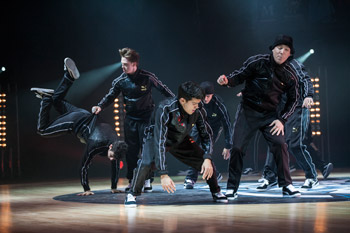 While attending the Professional Performing Arts School in Mahattan, Josh Peck studied musical theater. 'I'm also experienced in Bar Mitzvah dancing, quinceañera dancing and weddings. Anywhere dancing is promoted and appreciated, I'm involved somehow," he says. 'I always had a little bit of rhythm, perhaps more than people give me credit for. But I dance mostly by myself, alone, and it centers me."
While attending the Professional Performing Arts School in Mahattan, Josh Peck studied musical theater. 'I'm also experienced in Bar Mitzvah dancing, quinceañera dancing and weddings. Anywhere dancing is promoted and appreciated, I'm involved somehow," he says. 'I always had a little bit of rhythm, perhaps more than people give me credit for. But I dance mostly by myself, alone, and it centers me." In this film, however, he remains on the sidelines, dance-wise. 'Franklyn is a dancer in his heart, but nowhere else in his body," says Josh Peck. 'He's not the most physically gifted cat in the world. I think he would love to be a dancer, but he became an assistant at Dante's company instead. When Blake signs on as coach, Franklyn becomes his assistant because he has so much knowledge about dance and the hip hop world."
Josh Peck believes audiences will be blown away by the level of dance in Battle of Year. 'These dancers are like superheroes," he marvels. 'They are so talented and at the apex of what they do. It is such a different world than anything I've ever experienced. Dance is an equaliser. There's no advantage because of who you are or where you came from. It's purely based on skill and on how hard you've worked."
At Franklyn's urging, Dante brings in Stacey, a choreographer who works with the crew to refine their routines. 'We wanted to redefine some stereotypical characters as much as we did the urban dance genre," says Lee Benson. 'Stacey is not the usual babe-in-the-woods who comes from classical dance. She's an empowered and talented choreographer who can throw down just as hard as the guys. It's beautiful to see that synergy and have a character that avoids the typical clichés. She doesn't bring Blake back to life by becoming his romantic interest. They are comrades working together on a mission. She shows him that it's OK to take a look around and see life again. The way that they handled it was really beautiful and very natural."
Ten years of jazz and contemporary dance training prepared actress Caity Lotz to play the role. She began b-boying at the age of 17 and performed with the San Diego-based company, Culture Shock. 'It was all hip hop and breaking," she says. 'It was the first time I saw b-boys flipping and all that stuff. I've always been very acrobatic, and combining that with the dance drew me in. It's such an in-your-face performance style and so much fun."
Her character faces obstacles almost immediately, first with Blake, who doesn't see the need for a choreographer, then with the boys themselves, who assume the sweet-faced blonde is in over her head. 'My character has a lot to overcome," Caity Lotz says. 'Blake knows b-boys and he knows teams. But he finally realises that the performance is all about choreography. She brings that aspect of it. She is an amazing choreographer and she knows the guys need her, which helps her handle them."
Grammy®-winning recording artist Chris Brown plays Rooster, one of the most outstanding dancers on the Dream team. 'I wasn't really familiar with Chris Brown's music, but I was completely blown away by his talent," says Lee Benson. 'Chris Brown is the consummate performer. He really respects the craft of b-boying. He trained rigorously and his natural swagger is perfect for Rooster. He owns this character and there's no doubt that he's one of the best dancers out there today, but he's one of the boys on the set. He doesn't play the diva card at all."
Rooster becomes one of the group's leaders, which the filmmakers say came naturally to Chris Brown. 'Chris Brown brings so many things to this role like this," according to Vinson. 'It was a privilege to watch him work and he was a lot of fun to have on set."
Chris Brown has been interested in b-boying since he was a kid and his natural aptitude for dance helped him pick up the finer points relatively quickly. Still, he says this was the most difficult dancing he has ever done. 'Nobody's faking anything here," says Chris Brown. 'Working with these guys was inspiring for me. They really pushed me to do my best because they were so serious. They were always willing to show me how to do a move and they were really encouraging. I learned a lot and I think I walked away from this movie with a lot of new friendships."
Chris Brown says he loves acting and is always open to an interesting part, but he was hesitant to accept a role in a film about dance, especially since he is already well-known for his musical performances. 'The script was incredible, though," he says. 'The characters and the story made me want to be a part of it."
Chris Brown quickly learned that there's a big difference between performing and battling. 'When I go out on stage in front of 15,000 people, I know they came to see me," he says. 'Battling is ten times as hard because you face the judgment. If you mess up, they let you know."
The filmmakers were especially sensitive to representing real life b-boys when it came to casting the dancers in the film. The director and producer held four all-day sessions in several cities, bringing in dozens of potential team members to compete for a limited number of spots, just as the characters do in the film.
'To make a b-boy movie, we needed to have b-boys in it," says Lee Benson. 'What they do is very difficult. We couldn't just hire actors or other types of dancers, because it is so specific. We had auditions throughout the United States and we brought in some of the best b-boys around to play our Dream team."
Winning the trust of the b-boy community was a slow process. When breaking was the biggest pop-culture fad of the 1980s, many movies tried to portray the culture and most got it spectacularly wrong. 'The b-boy community became very insular," says Lee Benson. 'It went back underground in order to evolve. Because their image and their culture has been misrepresented in films for so long, b-boys are very skeptical about movies. They are not trustful of media people."
But the reputation Lee Benson built with Planet B-Boy opened doors for the production. 'They understood what I was trying to do," he says. 'When word got out in the community, they were very supportive."
The majority of the dancers in the cast are actual b-boys who underwent an extensive casting process that included documentary-style interviews to assess their personalities and on-camera charisma, as well as dance auditions. 'We asked them why they became b-boys and what it all means to them," says Amy Lo. 'Of course, we had them come in and dance. The two things together allowed us to see where they were coming from and helped give us ideas and inspiration for the characters.
'It was important to us that they represent themselves," she adds. 'They don't have a much of a voice in movies or in mainstream culture. They don't get featured front and center."
Using footage of the interviews and dance auditions, Lee Benson and Amy Lo put 'screen tests" of each promising dancer to show to the rest of the production team at Screen Gems. The final crew includes performers with colorful names like Lil Adonis, Kilowatt, Mayhem, Abstrak, Gillatine, SamO, Flipz and Do Knock. 'A b-boy name is pretty much everything to a b-boy," says Do Knock, whose given name is Jon Cruz. 'I remember the first time I heard a person on the East Coast call me Do-Knock. I thought, I never even met that guy before and he knows my name. It's like a stamp. When people start calling you by your b-boy name, you know you've made it."
He says that he has known many of the dancers on the shoot for years, if not personally, at least through their postings on the Internet. 'It's just crazy to see them on this film with me. It makes me happy because I feel so connected to them. B-boying is like one family. We have one voice. I can go to Korea and not speak a lick of Korean, but I can chill with one of the b-boys out there, because of that connection."
Of the 13 dancers who make the final cut, Do Knock is the one who challenges Rooster for leadership of the crew. 'Do Knock is actually a famous b-boy," says Vinson. 'He's in the documentary and he is really an exceptional talent. He moves like nobody I've seen. Do Knock, the character, and Rooster have an ongoing beef that may or not be about a girl. They're very competitive and split the team into two different factions."
Rooster and Do Knock's competition threatens to derail the team before they ever get started, says Lee Benson. 'They are two guys who need to let go of their egos and transcend the bickering. Ego is a very dangerous thing on a team like this. It gets in the way of your performance, your concentration and your teamwork. Their story is about letting go of that in order to work for a greater good."
The filmmakers were confident that they had great dancers and gave them the support they needed to blossom as actors. 'We focused on finding engaging personalities who were comfortable in front of the camera," says Lee Benson. 'Most of them had never acted before, but because they play characters or take on different personas when they dance, they understood performing.
We rehearsed for about two months, split between dancing and acting. One of the toughest things for any performer is to be themselves on camera and that's what we wanted from them. That was integral for these guys to achieve the level of acting that they did in the film. And they far exceeded what we expected of them."
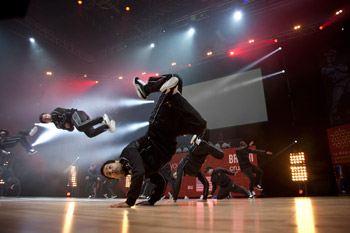 Live From Planet B-Boy
Live From Planet B-BoyBattle of the Year was filmed in Los Angeles and in Montpellier, France, where BOTY takes place each year. 'This was a global production," says Glenn S. Gainor. 'We brought over 75 people from around the world to the south of France for BOTY. We're the first Hollywood production to ever shoot in Montpellier. Europeans in general really embrace b-boying as an art form, so it was a great experience."
Many of the cast members had never been outside the United States before. 'They were in awe," Glenn Gainor says. 'Everybody who made this film grew through the experience and you can see that in the film as well. There's a great sense of sincerity when they look around and realise how far they've come."
Located on the coastline midway between Italy and Spain, Montpellier is an ancient French city studded with medieval architecture dating as far back as the 10th century. It provides a stark contrast to the b-boys' training ground in Southern California.
'The film goes from a very barren detention center outside of L.A. to this gorgeous old city," says Lee Benson 'It really communicates the diversity of this culture. Visually, both locations are stunning. The detention center has its own distinct history and then going to Montpellier and being surrounded by French history was just stunning for us all. I loved seeing the b-boys make that transition."
To ensure absolute authenticity, Gainor approached Thomas Hergenrother, founder of BOTY, and asked for his support in making the first real b-boy feature film. 'I knew that as the president of an organisation that helped legitimise b-boying, he would make sure we represented it in the right way," says the executive producer. 'Making that part of the shoot happen was a global operation. We had help from Paris, London, Tokyo, New York, Germany and Austria. The teams came in from Israel, Korea, Russia, Kazakhstan and America to compete at BOTY."
The filmmakers flew in Russia's team, Top Nine, to compete in a battle sequence with the Dream team before the competition started. 'We also put together a phenomenal group from Korea and flew them to Montpellier to dance in the film," says Glenn Gainor. 'And we have Vagabond, the No. 1 b-boy team in France, just as they were in the Battle of the Year."
Lee Benson says he was ecstatic when he learned they would be able to shoot during the actual competition. 'There's no event like it in the world. The energy and dynamic can't be reproduced. When we filmed the dance battles, I literally could not sit in my chair. I was jumping up and down because seeing these guys memorialised on film for this huge audience in 3-D blew me away. It made total sense to go there and it's another way to differentiate this film from other urban dance films that take place in the -hood."
The completed film combines footage that was specially staged for the movie, as well as live scenes from the actual event. 'We were able to shoot in the stadium a few days prior and mixed it with footage from the battle," says Amy Lo. 'Shooting the real BOTY is one of the most ambitious things I've seen done in a studio film. We had no control. The people in that stadium weren't there to watch us shoot a movie. They really couldn't have cared less about that. They just didn't want us to get in the way of their event."
With just 15 minutes to film the Dream team on the stadium stage, everything had to be perfectly timed. 'We had to have all five cameras and the dancers primed and ready," says Glenn Gainor. 'All the rehearsing and all the technical work paid off, but I was incredibly nervous when we finally got our guys on stage. They were in formation and nothing was happening. The crowd was going insane. Our guys were just standing there. I ran up to the first assistant director and I screamed, where's the music? He looked at me and he said, -four, three, two, one.' And then the music hit. It was that precise."
Lee Benson and his director of photography, Michael Barrett, used Sony's F3 3-D cameras for the majority of the shoot. During BOTY they also used the new Sony TD300 for the first time in a feature film. 'The F3s are terrific cameras," says Michael Barrett. 'Their sensitivity is incredible. We were often surprised by how little light we were able to use. The TD300 was irreplaceable because we often didn't have the physical space to put a crew. During BOTY, we had very few places to put our cameras, but you could just throw a TD300 on your shoulder. We had a guy hidden behind a speaker who got really terrific footage."
The filmmakers worked without storyboards and Michael Barrett was constantly improvising the best ways to capture the action. 'I had seen rehearsals, so I had some idea of what was happening," says the cinematographer. 'Every shot had at least three cameras rolling, and in the arena, we had as many as five. We would try to get a wide shot and two close-ups at the same time in the dramatic scenes."
Filming the competition at BOTY was like making a 3-D documentary, Michael Barrett adds. 'It was just fantastic. We were in the front row for one of the most exciting competitions I have ever witnessed. That sequence is phenomenal. To be that close to the dancers is an experience you just can't imagine. You have to see it."
Lee Benson was given a crash course in the art of 3-D filmmaking at The Sony 3-D Technology Center, which was founded to train and nurture filmmakers in the latest in 3-D developments. 'This is a second generation of 3-D films," he notes. 'The first generation was really about experimentation and refining the technology, as well as maximising the novelty of it. But it's no longer just about throwing stuff at people. It's also about the depth that you can produce in the world that you're creating.
'Dance is a natural genre for 3-D, there's no doubt about it," he continues. 'There have been a lot of 3-D dance movies made, but none that showcase the sportsmanship of b-boying. The 3-D creates a sense of dimensionality that enhances the story of these kids and what they go through. The audience will be immersed in it. With multiple cameras rolling at all times, we had so many wonderful angles to choose from."
Michael Barrett, who also shot Texas Chain Saw 3-D and A Very Harold & Kumar 3-D Christmas says there is nothing gimmicky about the way the technology is used here. 'It feels like you walk up to the screen and into this world. Dancing by nature is a spectacle and the 3-D heightened it. We've got guys performing incredible feats with their bodies, things you can't imagine are physically possible. When you see it in 3-D, it's absolutely astounding."
The production brought in three top choreographers to work with the b-boys: Dave Scott, and brothers Rich and Tone Talauega. 'Dave Scott has worked extensively in movies, on projects including You Got Served and Stomp the Yard," says Vinson. 'Rich and Tone are known for live events. We were introduced to them through Chris Brown. They have been creative directors on some of his shows. They are all very disciplined guys who run a tight ship and they were incredibly inspiring for the dancers."
The trio created dance sequences that embrace and elevate b-boying. 'It is an intensely physical discipline," Glenn Gainor says. 'They have to develop their neck muscles, their arm muscles and their shoulder muscles to an extraordinary degree. It takes real athleticism, stamina, talent and passion to excel in this art form. Everybody in the film brought their creativity to it. You're really experiencing the authentic dance."
The dancers and choreographers had six weeks prior to shooting to prep. They continued rehearsals and training throughout the shoot for sequences that include the show-stopping finale, in which they perform a complicated and dangerous dance routine blindfolded. 'That's never been done before," says Vinson. 'You can imagine how much rehearsal and timing it takes to get something like that right. It's the Dream team's secret weapon."
Dave Scott was eager to be involved in a project that he thinks will change the way people look at b-boying, but he was always aware that there would be certain unavoidable challenges. 'This is a dance style that is very individualistic," he points out. 'Our job was to make it more of a team sport without taking away the dancers' personal style. It's a whole new hybrid from of dance. In addition, the competitions are huge productions, almost like a circus. We had to come with something that is like a hip hop, b-boy, Broadway production number."
The choreographers also had to instill some of the discipline that more conventional forms like ballet require into the b-boy dancers. 'In the script, the Dream team starts out as a motley crew of cocky kids whose egos keep getting in the way," says Scott. 'And that is what we had to deal with in real life. I got grey hairs trying to unite these guys. But, as in the script, they slowly started to work together and become a family who help each other out."
The Talauega brothers were attracted to the idea of b-boying as sport. 'This script had all the right ingredients," says Tone. 'The story is timeless. The script is raw and comes from the streets. The fact that it is structured more like a sports story that a typical dance movie made us relate to it right away."
The brothers worked closely with Scott to turn the boys into a unified team. 'In front of the camera was exactly like what was going on behind the camera," says Rich. 'The dancers are so used to trying to stand out. During rehearsals, one guy would go off and start spinning on his head when we were doing something else. Another guy would start soloing while we were trying to work together, so it was a headache to get them all in the same frame of mind. So many worlds came together in this and it was our job to make them all one world."
Rich Talauega spent time working one-on-one with Chris Brown to transform him into an authentic b-boy. 'Chris is a sponge," the choreographer says. 'His dance talent is completely natural. He watches something and then does it perfectly the first time out. It's like he downloads it into his head. He is fearless and willing to try anything. Give him enough time, he will do it better than you!"
Benson Lee is extremely proud to have helmed what he believes is the first feature film that does justice to hip hop culture. 'In my opinion, Battle of the Year features the best urban dancing ever put on film," Lee Benson says. 'We have a great story with really phenomenal actors in a movie that will appeal to a wide audience. It has some really important, universal themes and the dancing is not only for young people.
'It is the first real showcase for b-boys in a narrative film," he continues. 'We have some of the best b-boys from around the world representing a whole era of world class b-boying. I want more people to want to learn about the art of b-boying. I want to help it transcend that worn out image from the '80s. It is a dynamic and powerful form of dance. It is a sport. It is an art.
'And for the kids who get involved, it provides them an opportunity to shine. Some of them would never have had that chance to leave their neighborhoods and this has allowed them to see the world. It's amazing."
Battle Of The Year
Release Date: December 12th, 2013
MORE





